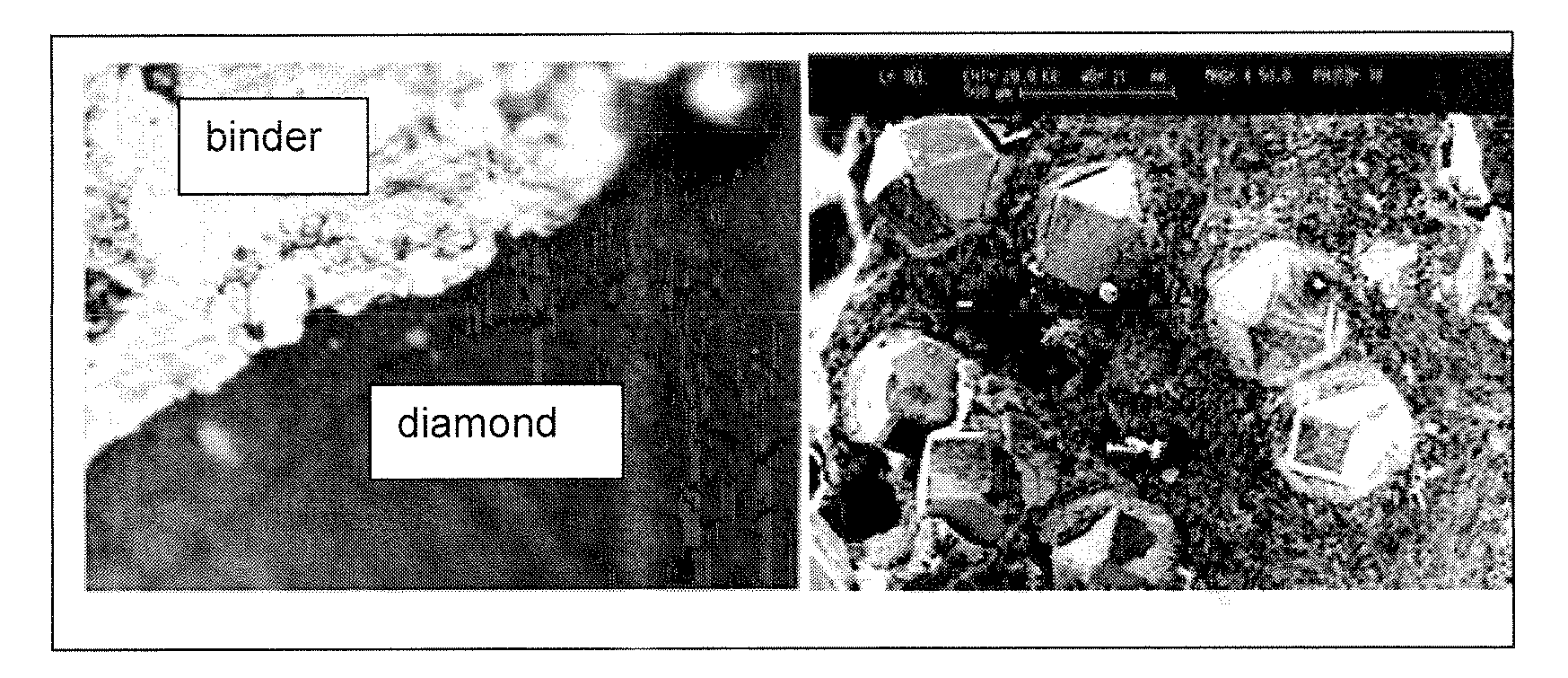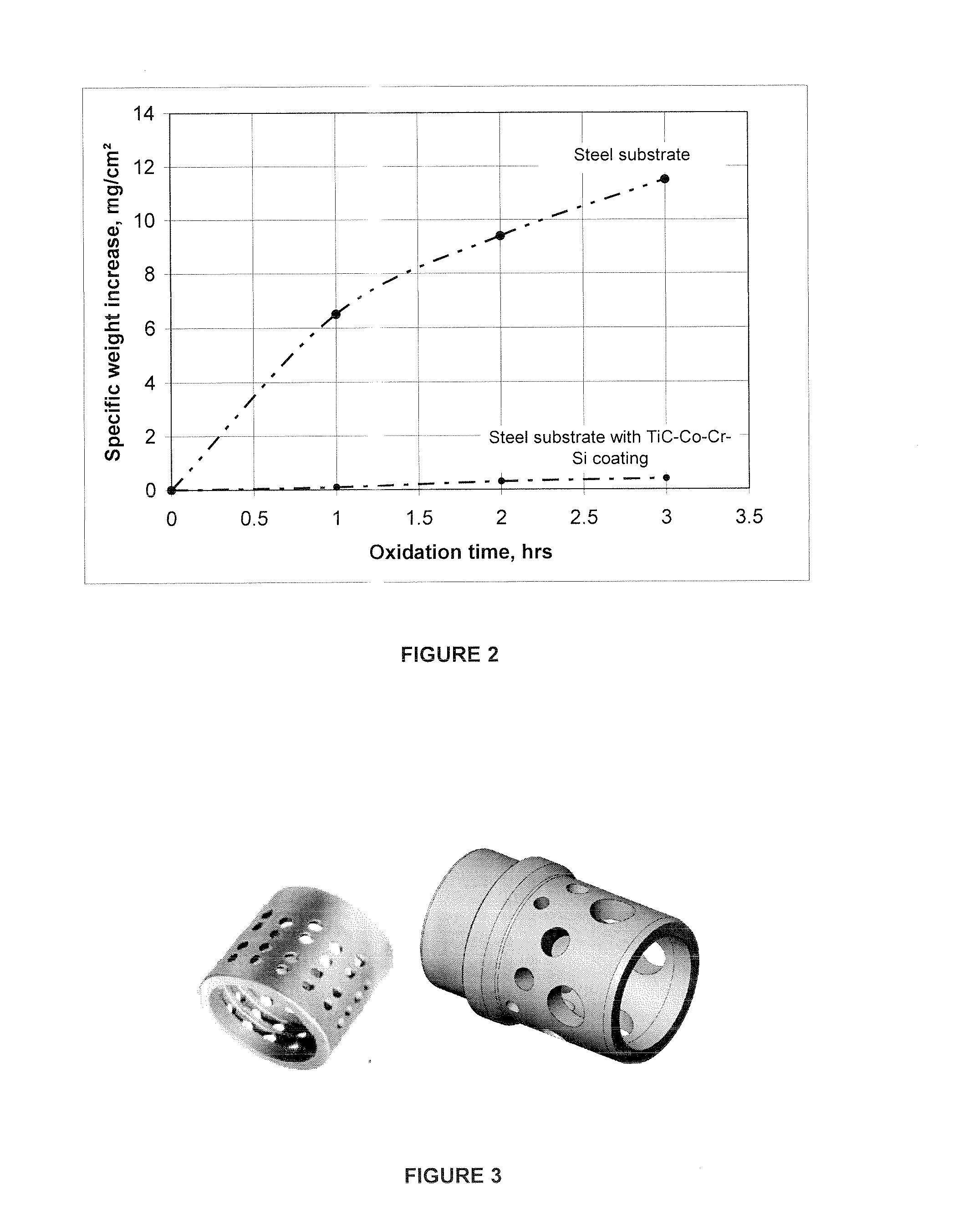Wear part with hard facing
a technology of hard facing and wear parts, applied in the direction of pretreatment surfaces, superimposed coating processes, coatings, etc., can solve the problems of high density and cost, degradation or melting of steel substrates, dense layer of mechanically keyed hard particles becoming attached to the surface, etc., and achieve the effect of sufficient robust handling and degree of flexibility
- Summary
- Abstract
- Description
- Claims
- Application Information
AI Technical Summary
Benefits of technology
Problems solved by technology
Method used
Image
Examples
example 2
[0079]A 1 kg batch of powders comprising 67 wt. % WC powder with a mean diameter of about 0.8 μm, 24 wt. % Co powder, 6.4% Cr3C2 powder and 1.6 wt. % Si powder was milled for six hours in an attritor mill in a medium of hexane and 20 g paraffin wax and 6 kg hard-metal balls. After milling, the resulting slurry was dried and the powder was screened to eliminate agglomerates. Diamond grains with mean diameter in the range 300 to 400 um and having a TiC coating with average thickness about 0.5 um were introduced to the resulting powder at a level of 7 wt. %, and blended into the powder by means of a Turbular mixer. The weight percentage of diamond added was calculated to correspond to 20 vol. % diamond in the final sintered product. So, at this stage the mixture comprised 63 wt % WC, 22.5 wt. % Co, 7 wt. % diamond arains, 6 wt. % Cr3C2 and 1.5 wt. % Si.
[0080]The powder mixture was compacted by means of a conventional cold press to form cylindrically-shaped samples, which were sintered ...
example 3
[0082]A 1 kg batch of powders comprising 30 wt. % WC powder with a mean diameter of about 0.8 μm, 30 wt. % TiC, 20 wt. % Co powder, 10% Cr3C2 powder and 10 wt. % Si powder was milled for one hour in an attritor mill in a medium of hexane with 6 kg hard-metal balls. After milling, the resulting slurry was dried and the powder was screened to eliminate agglomerates. The resulting powder was mixed with 10% organic binder DECOFLUX® (Zschimmer & Schwarz). The paste obtained in such a way was applied onto the surface of steel substrates (carbon steel, ST50). The substrates with a layer of the paste were heat-treated in vacuum at a temperature of 1220 deg. C. for 2 min to form a continuous coating of roughly 3 mm in thickness on the steel substrate. The coated steel substrates were heat-treated by use of a conventional procedure for heat-treating steels.
[0083]The microstructure of the wear-resistant layer comprises facetted or rounded WC and TiC grains of 0.5 to 3.0 μm, rounded grains of (...
example 4
[0087]A paste was prepared comprising particles of 53 vol. % WC, 9 vol. % Cr3C2, 3 vol. % Si, 35 vol. % Co and an organic binder. The paste was applied to a portion of the steel body of a pick tool to form a layer with thickness in the range 2 to 3 mm and dried. Conventional brazing equipment was used to melt the paste in a non-oxidising atmosphere for about one minute at an applied temperature of about 1200 deg. C., above the melting point of the paste in the presence of iron at the interface with the steel substrate. The fact that conventional brazing equipment may be used to apply the hard facing is considered to be an important benefit of this method. The uncertainty in the temperature was about 30 deg. C, and it is believed that the applied temperature was about 1250 deg. C. The molten paste was found to be sufficiently viscous that it did not flow substantially during the brazing process. It is believed that the presence of Co in the paste enables brazing to be completed succe...
PUM
| Property | Measurement | Unit |
|---|---|---|
| thickness | aaaaa | aaaaa |
| thickness | aaaaa | aaaaa |
| thickness | aaaaa | aaaaa |
Abstract
Description
Claims
Application Information
 Login to View More
Login to View More - R&D
- Intellectual Property
- Life Sciences
- Materials
- Tech Scout
- Unparalleled Data Quality
- Higher Quality Content
- 60% Fewer Hallucinations
Browse by: Latest US Patents, China's latest patents, Technical Efficacy Thesaurus, Application Domain, Technology Topic, Popular Technical Reports.
© 2025 PatSnap. All rights reserved.Legal|Privacy policy|Modern Slavery Act Transparency Statement|Sitemap|About US| Contact US: help@patsnap.com



